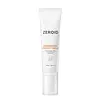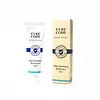What's inside
What's inside
 Key Ingredients
Key Ingredients

 Benefits
Benefits

 Concerns
Concerns

 Ingredients Side-by-side
Ingredients Side-by-side

Water
Skin ConditioningGlycerin
HumectantPanthenol
Skin ConditioningVegetable Oil
Skin ConditioningCetearyl Alcohol
Emollient1,2-Hexanediol
Skin ConditioningPolyglyceryl-3 Methylglucose Distearate
EmulsifyingCaprylic/Capric Triglyceride
MaskingOlea Europaea Fruit Oil
MaskingSqualane
EmollientSorbitan Stearate
EmulsifyingNiacinamide
SmoothingGlyceryl Stearate
EmollientTrimethylsiloxysilicate
EmollientStearic Acid
CleansingCyclopentasiloxane
EmollientPolyglyceryl-10 Distearate
EmulsifyingMyristoyl/Palmitoyl Oxostearamide/Arachamide Mea
Skin ConditioningDipentaerythrityl Hexa C5-9 Acid Esters
Skin ConditioningPhytosterols
Skin ConditioningCaprylyl Glycol
EmollientPolyacrylate Crosspolymer-11
Emulsion StabilisingTocopherol
AntioxidantXanthan Gum
EmulsifyingAllantoin
Skin ConditioningMethyl Caprooyl Tyrosinate
Skin ProtectingSodium Hyaluronate
HumectantDisodium EDTA
Butylene Glycol
HumectantMadecassoside
AntioxidantBeta-Glucan
Skin ConditioningPolyglyceryl-10 Laurate
Skin ConditioningPalmitoyl Pentapeptide-4
Skin ConditioningWater, Glycerin, Panthenol, Vegetable Oil, Cetearyl Alcohol, 1,2-Hexanediol, Polyglyceryl-3 Methylglucose Distearate, Caprylic/Capric Triglyceride, Olea Europaea Fruit Oil, Squalane, Sorbitan Stearate, Niacinamide, Glyceryl Stearate, Trimethylsiloxysilicate, Stearic Acid, Cyclopentasiloxane, Polyglyceryl-10 Distearate, Myristoyl/Palmitoyl Oxostearamide/Arachamide Mea, Dipentaerythrityl Hexa C5-9 Acid Esters, Phytosterols, Caprylyl Glycol, Polyacrylate Crosspolymer-11, Tocopherol, Xanthan Gum, Allantoin, Methyl Caprooyl Tyrosinate, Sodium Hyaluronate, Disodium EDTA, Butylene Glycol, Madecassoside, Beta-Glucan, Polyglyceryl-10 Laurate, Palmitoyl Pentapeptide-4
Water
Skin ConditioningNiacinamide
Smoothing1,2-Hexanediol
Skin ConditioningPanthenol
Skin ConditioningEthyl Linoleate
EmollientCaprylic/Capric Triglyceride
MaskingCetearyl Alcohol
EmollientAmmonium Acryloyldimethyltaurate/Vp Copolymer
Centella Asiatica Extract
CleansingAcetyl Glucosamine
Skin ConditioningBifida Ferment Lysate
Skin ConditioningResveratrol
AntioxidantPolyglyceryl-10 Distearate
EmulsifyingGlyceryl Stearate
Emollient4-T-Butylcyclohexanol
MaskingSodium Hyaluronate
HumectantSorbitan Stearate
EmulsifyingPhytosterols
Skin ConditioningN-Palmitoyl Serinol
Skin ProtectingHypericum Perforatum Flower Extract
Skin ConditioningButylene Glycol
HumectantPalmitic Acid
EmollientCeramide NP
Skin ConditioningCarbomer
Emulsion StabilisingPalmitoyl Tetrapeptide-10
Skin ConditioningAcetyl Dipeptide-1 Cetyl Ester
Skin ConditioningSialyllactose
Skin ConditioningCetyl Palmitate
EmollientStearic Acid
CleansingPolysorbate 80
EmulsifyingPentylene Glycol
Skin ConditioningAllantoin
Skin ConditioningSodium Benzoate
MaskingHydrogenated Lecithin
EmulsifyingCitric Acid
BufferingSorbitan Laurate
EmulsifyingMyristic Acid
CleansingTocopherol
AntioxidantHydroxyethylcellulose
Emulsion StabilisingWater, Niacinamide, 1,2-Hexanediol, Panthenol, Ethyl Linoleate, Caprylic/Capric Triglyceride, Cetearyl Alcohol, Ammonium Acryloyldimethyltaurate/Vp Copolymer, Centella Asiatica Extract, Acetyl Glucosamine, Bifida Ferment Lysate, Resveratrol, Polyglyceryl-10 Distearate, Glyceryl Stearate, 4-T-Butylcyclohexanol, Sodium Hyaluronate, Sorbitan Stearate, Phytosterols, N-Palmitoyl Serinol, Hypericum Perforatum Flower Extract, Butylene Glycol, Palmitic Acid, Ceramide NP, Carbomer, Palmitoyl Tetrapeptide-10, Acetyl Dipeptide-1 Cetyl Ester, Sialyllactose, Cetyl Palmitate, Stearic Acid, Polysorbate 80, Pentylene Glycol, Allantoin, Sodium Benzoate, Hydrogenated Lecithin, Citric Acid, Sorbitan Laurate, Myristic Acid, Tocopherol, Hydroxyethylcellulose
Ingredients Explained
These ingredients are found in both products.
Ingredients higher up in an ingredient list are typically present in a larger amount.
1,2-Hexanediol is a synthetic liquid and another multi-functional powerhouse.
It is a:
- Humectant, drawing moisture into the skin
- Emollient, helping to soften skin
- Solvent, dispersing and stabilizing formulas
- Preservative booster, enhancing the antimicrobial activity of other preservatives
Allantoin is a soothing ingredient known for its protective and moisturizingg properties. Because of this, it is often added to products with strong active ingredients.
Studies show higher concentrations of this ingredient can promote wound healing.
Though it can be derived from the comfrey plant, allantoin is produced synthetically for cosmetic products to ensure purity.
Learn more about AllantoinButylene Glycol (or BG) is used within cosmetic products for a few different reasons:
Overall, Butylene Glycol is a safe and well-rounded ingredient that works well with other ingredients.
Though this ingredient works well with most skin types, some people with sensitive skin may experience a reaction such as allergic rashes, closed comedones, or itchiness.
Learn more about Butylene GlycolThis ingredient is an emollient, solvent, and texture enhancer. It is considered a skin-softener by helping the skin prevent moisture loss.
It helps thicken a product's formula and makes it easier to spread by dissolving clumping compounds.
Caprylic Triglyceride is made by combining glycerin with coconut oil, forming a clear liquid.
While there is an assumption Caprylic Triglyceride can clog pores due to it being derived from coconut oil, there is no research supporting this.
Learn more about Caprylic/Capric TriglycerideCetearyl alcohol is a mixture of two fatty alcohols: cetyl alcohol and stearyl alcohol. It is mainly used as an emulsifier. Emulsifiers help prevent the separation of oils and products. Due to its composition, it can also be used to thicken a product or help create foam.
Cetearyl alcohol is an emollient. Emollients help soothe and hydrate the skin by trapping moisture.
Studies show Cetearyl alcohol is non-toxic and non-irritating. The FDA allows products labeled "alcohol-free" to have fatty alcohols.
This ingredient is usually derived from plant oils such as palm, vegetable, or coconut oils. There is debate on whether this ingredient will cause acne.
Due to the fatty acid base, this ingredient may not be Malassezia folliculitis safe.
Learn more about Cetearyl AlcoholGlyceryl Stearate is a mix of glycerin and stearic acid.
It is used to stabilize the mixing of water and oil ingredients. By preventing these ingredients from separating, it can help elongate shelf life. It can also help thicken the product's texture.
As an emollient, it helps soften skin and supports barrier-replenishing ingredients.
In cosmetics, Glyceryl Stearate is often made from vegetable oils or synthetically produced.
This ingredient may not be fungal-acne safe
Fun fact: The human body also creates Glyceryl Stearate naturally.
Learn more about Glyceryl StearateNiacinamide is a multitasking form of vitamin B3 that strengthens the skin barrier, reduces pores and dark spots, regulates oil, and improves signs of aging.
And the best part? It's gentle and well-tolerated by most skin types, including sensitive and reactive skin.
You might have heard of "niacin flush", or the reddening of skin that causes itchiness. Niacinamide has not been found to cause this.
In very rare cases, some individuals may not be able to tolerate niacinamide at all or experience an allergic reaction to it.
If you are experiencing flaking, irritation, and dryness with this ingredient, be sure to double check all your products as this ingredient can be found in all categories of skincare.
When incorporating niacinamide into your routine, look out for concentration amounts. Typically, 5% niacinamide provides benefits such as fading dark spots. However, if you have sensitive skin, it is better to begin with a smaller concentration.
When you apply niacinamide to your skin, your body converts it into nicotinamide adenine dinucleotide (NAD). NAD is an essential coenzyme that is already found in your cells as "fuel" and powers countless biological processes.
In your skin, NAD helps repair cell damage, produce new healthy cells, support collagen production, strengthen the skin barrier, and fight environmental stressors (like UV and pollution).
Our natural NAD levels start to decline with age, leading to slower skin repair, visible aging, and a weaker skin barrier. By providing your skin niacinamide, you're recharging your skin's NAD levels. This leads to stronger, healthier, and younger looking skin.
Another name for vitamin B3 is nicotinamide. This vitamin is water-soluble and our bodies don't store it. We obtain Vitamin B3 from either food or skincare. Meat, fish, wheat, yeast, and leafy greens contain vitamin B3.
The type of niacinamide used in skincare is synthetically created.
Learn more about NiacinamidePanthenol is a common ingredient that helps hydrate and soothe the skin. It is found naturally in our skin and hair.
There are two forms of panthenol: D and L.
D-panthenol is also known as dexpanthenol. Most cosmetics use dexpanthenol or a mixture of D and L-panthenol.
Panthenol is famous due to its ability to go deeper into the skin's layers. Using this ingredient has numerous pros (and no cons):
Like hyaluronic acid, panthenol is a humectant. Humectants are able to bind and hold large amounts of water to keep skin hydrated.
This ingredient works well for wound healing. It works by increasing tissue in the wound and helps close open wounds.
Once oxidized, panthenol converts to pantothenic acid. Panthothenic acid is found in all living cells.
This ingredient is also referred to as pro-vitamin B5.
Learn more about PanthenolPhytosterols come from plants, nuts, and whole grains. These compounds have skin soothing and moisturizing properties.
Fun fact: They are similar to cholesterol and can help lower cholesterol levels.
Polyglyceryl-10 Distearate isn't fungal acne safe.
Sodium Hyaluronate is hyaluronic acid's salt form. It is commonly derived from the sodium salt of hyaluronic acid.
Like hyaluronic acid, it is great at holding water and acts as a humectant. This makes it a great skin hydrating ingredient.
Sodium Hyaluronate is naturally occurring in our bodies and is mostly found in eye fluid and joints.
These are some other common types of Hyaluronic Acid:
Learn more about Sodium HyaluronateSorbitan Stearate comes from sorbitol and stearic acid. Sorbitol is a type of sugar and stearic acid is a fatty acid.
It is used as an emulsifier and helps ingredients stay together by creating water-in-oil emulsions.
This ingredient may not be Malassezia folliculitis, or fungal-acne safe.
Stearic Acid is a fatty acid. It is an emollient, emulsifier, and texture enhancer.
As an emollient, stearic acid helps soften skin. It aids the skin's protective barrier by preventing water loss. It also provides a gentle cleansing effect without stripping away natural oils.
Stearic acid may also be used to enhance the texture of products. It can add volume and stabilize ingredients such as water and oil. This can help water and oil ingredients from separating.
Sources of stearic acid include animal or vegetable fats/oils such as coconut or shea. It can be naturally found in butter, cocoa butter, shea butter, vegetable fats, and animal tallow.
This ingredient may not be Malassezia folliculitis, or fungal-acne safe.
Learn more about Stearic AcidTocopherol (also known as Vitamin E) is a common antioxidant used to help protect the skin from free-radicals and strengthen the skin barrier. It's also fat soluble - this means our skin is great at absorbing it.
Vitamin E also helps keep your natural skin lipids healthy. Your lipid skin barrier naturally consists of lipids, ceramides, and fatty acids. Vitamin E offers extra protection for your skin’s lipid barrier, keeping your skin healthy and nourished.
Another benefit is a bit of UV protection. Vitamin E helps reduce the damage caused by UVB rays. (It should not replace your sunscreen). Combining it with Vitamin C can decrease sunburned cells and hyperpigmentation after UV exposure.
You might have noticed Vitamin E + C often paired together. This is because it is great at stabilizing Vitamin C. Using the two together helps increase the effectiveness of both ingredients.
There are often claims that Vitamin E can reduce/prevent scarring, but these claims haven't been confirmed by scientific research.
Learn more about TocopherolWater. It's the most common cosmetic ingredient of all. You'll usually see it at the top of ingredient lists, meaning that it makes up the largest part of the product.
So why is it so popular? Water most often acts as a solvent - this means that it helps dissolve other ingredients into the formulation.
You'll also recognize water as that liquid we all need to stay alive. If you see this, drink a glass of water. Stay hydrated!
Learn more about Water